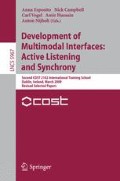Abstract
Descriptions of emotional voice type have typically been provided in terms of fundamental frequency (f0), intensity and duration. Further features, such as measures of laryngeal characteristics, may help to improve recognition of emotional colouring in speech, and, expressiveness in speech synthesis. The present contribution examines three temporal measures of vocal fold opening – as indicated by the time of decreasing contact of the vocal folds estimated from the electroglottogram signal. This initial investigation, using a single female speaker, analyses the sustained vowel [a:], produced when simulating the emotional states anger, joy, neutral, sad and tender. The results indicate discrimination of emotional voice type using two of the measures of vocal fold opening duration.
Access this chapter
Tax calculation will be finalised at checkout
Purchases are for personal use only
Preview
Unable to display preview. Download preview PDF.
References
Airas, M., Alku, P.: Emotions in vowel segments of continuous speech: analysis of the glottal flow using the normalized amplitude quotient. Phonetica 63, 26–46 (2006)
McGilloway, S., Cowie, R., Douglas-Cowie, E., Gielen, S., Westerdijk, M., Stroeve, S.: Approaching automatic recognition of emotion from voice: a rough benchmark. In: Proceedings of the ISCA workshop on Speech and Emotion, Belfast, pp. 207–212 (2000)
Toivanen, J., Waaramaa, T., Alku, P., Laukkanen, A.-M., Seppänen, T., Väyrynen, E., Airas, M.: Emotions in [a]: A perceptual and acoustic study. Logopedics Phoniatrics Vocology 31, 43–48 (2006)
Gobl, C., Ní Chasaide, A.: The role of voice quality in communicating emotion, mood and attitude. Speech Communication 40, 189–212 (2003)
Yanushevskaya, I., Tooher, M., Gobl, C.: Time- and amplitude-based voice source correlates of emotional portrayals. In: Proceedings of Affective Computing and Intelligent Interaction, ACII, Lisbon, pp. 159–170 (2007)
Laukkanen, A.-M., Vilkman, E., Alku, P., Oksanen, H.: Physical variations related to stress and emotional state: a preliminary study. J. Phonetics 24, 313–335 (1996)
Cummings, K.E., Clements, M.A.: Analysis of the glottal excitation of emotionally styled and stressed speech. J. Acoust. Soc. Am. 98, 88–98 (1995)
Rossato, S., Audibert, N., Aubergé, V.: Emotional voice measurement: A comparison of articulatory-EGG and acoustic amplitude parameters. In: Proceedings of the 2nd Int. Conf. on Speech Prosody, Nara, Japan, pp. 749–752 (2004)
Murphy, P.J., Laukkanen, A.-M.: Electroglottogram analysis of emotionally styled phonation. In: Esposito, A., Hussain, A., Marinaro, M., Martone, R. (eds.) Multimodal Signals: Cognitive and Algorithmic Issues. LNCS (LNAI), vol. 5398, pp. 264–270. Springer, Heidelberg (2009)
Murphy, P., Laukkanen, A.-M.: Investigation of Normalised Time of Increasing Vocal Fold Contact as a Discriminator of Emotional Voice Type. In: Esposito, A., et al. (eds.) Proceedings of the 2nd COST 2102 International Conference on Cross-Modal Analysis of Speech, Gesture, Gaze and Facial Expressions Prague. LNCS (LNAI). Springer, Heidelberg (2009)
Rothenberg, M., Mashie, J.: Monitoring vocal fold abduction through vocal fold contact area. J. Speech Hear Res. 31, 338–351 (1988)
Titze, I.: Interpretation of the electroglottographic signal. J. Voice 4, 1–9 (1990)
Henrich, N., d’Alessandro, C., Castellengo, M., Doval, B.: On the use of the derivative of electroglottographic signals for characterization of nonpathological phonation. J. Acoust. Soc. Am. 115, 1321–1332 (2004)
Childers, D.G., Hicks, D.M., Moore, G.P., Eskenazi, L., Lalwani, A.L.: Electroglottography and vocal fold physiology. J. Speech Hear. Res. 33, 245–254 (1990)
Titze, I.: Parameterization of the glottal area, glottal flow, and vocal fold contact area J. Acoust. Soc. Am. 75, 570–580 (1984)
Author information
Authors and Affiliations
Editor information
Editors and Affiliations
Rights and permissions
Copyright information
© 2010 Springer-Verlag Berlin Heidelberg
About this chapter
Cite this chapter
Murphy, P.J., Laukkanen, AM. (2010). Analysis of Emotional Voice Using Electroglottogram-Based Temporal Measures of Vocal Fold Opening. In: Esposito, A., Campbell, N., Vogel, C., Hussain, A., Nijholt, A. (eds) Development of Multimodal Interfaces: Active Listening and Synchrony. Lecture Notes in Computer Science, vol 5967. Springer, Berlin, Heidelberg. https://doi.org/10.1007/978-3-642-12397-9_24
Download citation
DOI: https://doi.org/10.1007/978-3-642-12397-9_24
Publisher Name: Springer, Berlin, Heidelberg
Print ISBN: 978-3-642-12396-2
Online ISBN: 978-3-642-12397-9
eBook Packages: Computer ScienceComputer Science (R0)

